If you don’t know your way around a diamond ring, stumbling into a jewelry store can be quite the experience. If you don’t know a whole lot about gold, you might really find yourself in a pickle.
Lucky for you, gold can be broken down into simple terms. It’s is a valuable and super soft metal. You may have heard that it’s measured in karats. This karat measurement is different than carats in a diamond. Carats in a diamond are used to measure the size of the stone. Karats in gold are units to measure the purity of it.
If you own a piece of gold jewelry, you may notice some tiny little markings on it. If the piece is bought from a jewelry store, you’ll probably see the markings 14KT or K. We can assume that KT/kt means karat. But what about those numbers? Well, it can be broken down quite simply.
[toc]The Breakdown of Gold Jewelry
Let’s say all gold (white, yellow, rose, and black gold) is made up of 24 parts. Yes, we’re doing fractions. You might be surprised to know that most gold pieces aren’t actually made up of 100% gold. In fact, very few pieces are 24kts, which is also known as pure gold.
Also read: Know More about Platinum, White Gold, Yellow Gold and Rose Gold
Instead, it is mixed with alloy. Alloy metal is just a fancy name for a bunch of other metals like silver, palladium, copper, nickel, and zinc. Nickel is less used now in alloy metal due to so many having a nickel allergy.
For the most part, gold comes in 10kt, 14kt, 18kt, and 24kt. Sometimes, you may find 22kt. Most designers don’t do anything below 10kt, because anything less than 10kt isn’t great quality.
It used to be that anything below 10kt could not be described as karat gold, dictated by the FTC (Federal Trade Commission). But in July of 2018, they changed it. Now, anything can be described as gold, as long as at least 3% of those 24 parts are gold. But honestly, anything below 10kt is barely gold and beneath most jewelry stores.
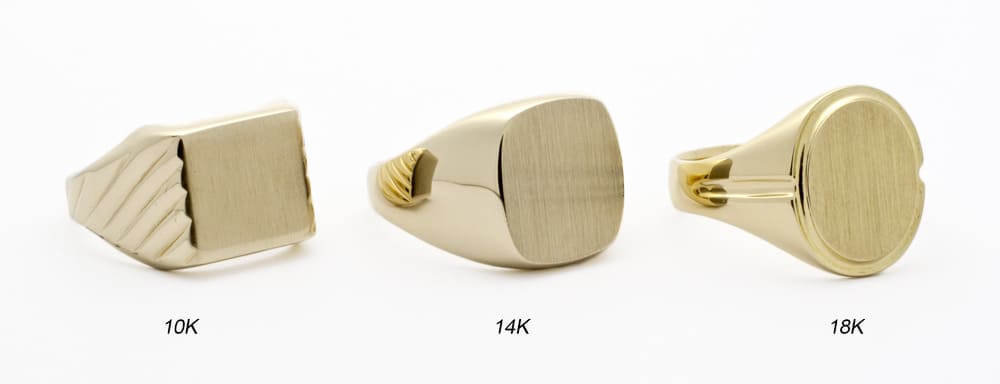
Contrary to popular belief, there is no legal guideline on displaying the karat stamp on pieces of gold jewelry. However, in the context of purchasing at a jewelry store, you should be wary if you don’t see a stamp with the karat amount in it. Always get those pieces tested before you buy. They are obligated to tell you how many karats are in a piece.
So, with all this in mind, which of the karats is the best? It really depends on what you’re looking for. Is it for special occasions? Or maybe every day wear? There is no right answer. But let’s look at the benefits and negatives of each, shall we?
10K vs 14K vs 18K vs 24K Gold Side by Side
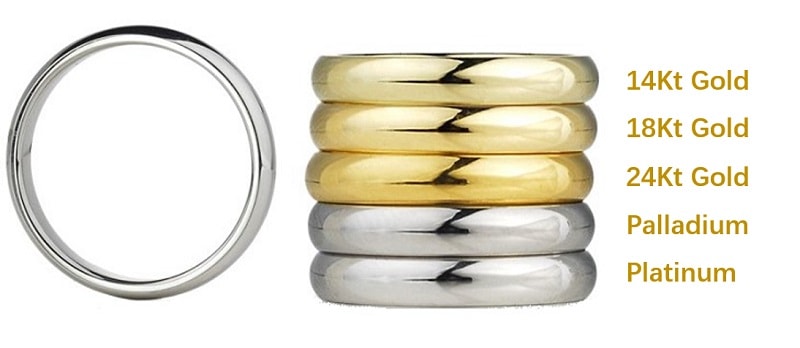
10K Gold
You already know that 10kt is the least amount of karats in a piece you might find at a jewelry store. These pieces should be either market 10kt, 10K or .417. It means that out of the 24 parts of gold in a piece, 10 parts of them are pure. The other remaining 14 are a combination of alloy metals. This is also 41.7% pure.
Because it is made of more alloy than gold, 10kt is the most durable. You might find 10kt to be more common in men’s wedding bands than women’s. In general, men are harder on their hands than women. The durability of 10kt gold jewelry can survive and sustain better than higher karats.
You may be interested: What Does The “925” Mark On Gold Jewelry Mean?
Another benefit of 10kt is that these pieces are more affordable for those on a budget, or those who don’t want to spend a whole lot. However, be aware that due to a higher content of alloy, 10kt pieces may tarnish faster.
While cost-efficient, 10kt gold might not be a great option if you’re looking to have bigger and better clarity diamonds in the piece. Most 10kt pieces are accompanied with diamonds of a lower class. Of course, not everyone is looking for that, and that’s okay.
Lastly, 10kt pieces are not recommended for those with metal allergies. Because it has more alloy content than gold, these pieces are more likely to irritate the skin and cause allergic reactions.
14K Gold
This is the most common type of gold jewelry you’ll find in many retailers. 14kt is a great middle level mixture of gold and alloy. With it being 58.3% pure, it’s still durable enough for everyday situations. 14kt pieces can be stamped with 14kt, 14k .583, or .585.
14kt gold also has a richer color than 10kt. Most can’t tell the difference, but the purity of it allows for a more golden color.
While the appearance may be brighter and more vivid, 14kt takes a little more upkeep than 10kt jewelry pieces. The higher content of gold in 14kt jewelry will cause it to scratch easier. Of course, these issues can be taken care of by a jeweler.
Guess you like: Is 14K Gold A Good Value?
On average, 14kt pieces are less durable than their usual comparison to 10kt. However, there are some really great quality 14kt jewelry that are mixed with certain types of alloy that cause it to be stronger. It depends on how much of certain metals that make up the alloy metal.
These pieces are considerably more expensive than 10kt pieces. However, 14kt is still affordable for most. This is why 14kt is the most common karat of gold you will find. It’s less likely to bring up an allergy, but it is still possible.
18K Gold
If you’re a connoisseur of jewelry, you might be interested in 18kt gold pieces. These pieces tend to be more vintage, as 18kt used to be the traditional choice in gold. 18kt jewelry is 75% pure and may be stamped 18kt, 18k, or .750.
18kt pieces are more fragile than 14kt or 10kt pieces. The gold is much weaker too. This can cause issues with prongs that hold stones. You want prongs to be strong, as they will hold your stone. Should those prongs be too weak, you could lose your stone.
18kt will scratch easier than both and may be liable to break. They should be handled with care and admiration. The color of 18kt pieces is more yellow, which makes it extremely beautiful in appearance.
With 18kt being 75% pure, you can only imagine how costly these pieces might be. They are considerably more expensive than 14kt jewelry. Also, 18kt jewelry pieces will be heavier than 14kt or 10kt. The weight of an 18kt piece could bother someone who isn’t thrilled about wearing rings, or someone who isn’t used to wearing rings.
If you decide to purchase an 18kt piece, be careful with it. These pieces are not good to wear in everyday situations or anywhere near manual labor. Because of their delicacy, it’s likely you’ll have to take it to be polished and buffed more often. The price of the upkeep may not be within your budget.
Even though 18kt gold pieces cost more, they sure are a sight to behold. They are beautiful and luxurious, drawing attention from everyone who lay eyes upon them. They may require a little extra TLC, but these pieces are definitely a statement.
24K Gold
24kt gold is as pure as it gets. Being almost 100% gold, you are not likely to find 24kt jewelry. If you were to have a 24kt piece, it will likely break, bend, or scratch due to the fragility of the soft metal.
Although it probably goes without saying, 24kt gold is very expensive. Most people that own something in 24kt would probably be celebrities or someone with a considerable amount of money.
While you won’t find many 24kt pieces in America, there are other places that may carry them such as Europe and Asia.
Learn More: Gold Vermeil Vs Gold Plated Vs Gold Filled: Know it Better
When it comes to color, there is no comparison. By appearance, 24kt gold will always be more exquisite than any of the lower karat amounts.
The deep, rich, yellow color is to die for. But durability and practicality-wise, not so much. 24kt pieces are best left for special occasions.
What is the Value of Gold?
If you’re looking to sell a piece of gold jewelry, you might be curious to know what the value of gold is. You also might be interested to know the value of gold changes based on different factors. Here are a few factors that might affect the value of the luxury metal:
- The Federal Reserve
The Federal Reserve controls the monetary policy, which dictates interest rates and money supply. It also controls inflation, which is very important when regarding the value. Gold is known as an inflation hedge, which basically means it is supposed to increase in value over time.
- Economy
Sadly enough, when the economy is weaker, this metal rises in value. A stronger economy has the potential to decrease the value. The Federal Reserve takes the economy into consideration when determining the money policy.
- Inflation
The cost of items and services has a tendency to rise up and come back down. When the inflation is high, the price of gold is higher. When it’s low, the value decreases.
There are other factors that determine the value, but mainly it’s about economy. There are websites you can see that will tell you the price of gold each day and show you how the value fluctuates.
The best option when determining the value of your gold piece is to take it to an appraiser. These people are trained to take all of these factors in and make an educated decision on how much your piece is worth. Make sure you do your research too, so you don’t get ripped off.
Look for The Stamp
Now that you are up to speed on the differences between 10k vs 14k vs 18k vs 24k gold jewelry, there’s one more piece of advice to leave you with.
No matter which karat amount you choose, remember that all gold pieces should be stamped with the karat weight. Legally, they don’t have to be. But, they are legally obligated to disclose the amount of gold in the piece no matter what.
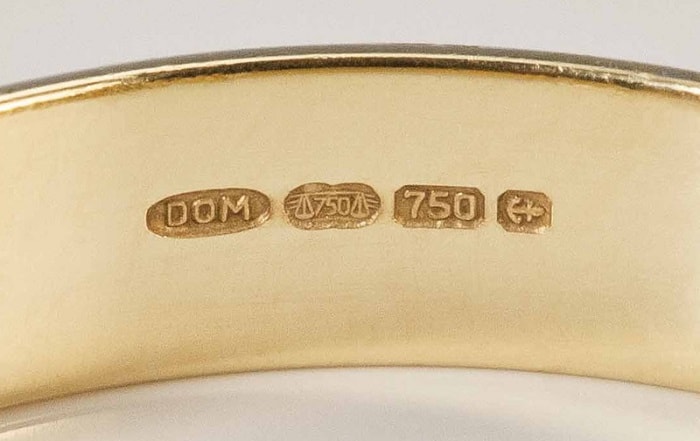
For chains and bracelets, you should see the stamping somewhere on the clasp normally. Pendants should be stamped too, even if they come with the chain. On earrings, they are generally on the setting, but sometimes on the post in very tiny print. Lastly, rings should have their stamping on the inside of the band.
Most of the time, you can see the stamping on an engagement or wedding ring without needing it magnified. But for other pieces, you may need a loupe or magnifying glass.
Sometimes the stamping is cut out when it is sized. It shouldn’t be, but it does happen. Make sure your stamping is still there when getting your ring back from a jeweler. If it starts to fade, you can always get it re-stamped.
Related: Gold Markings and Their Meaning
Be wary if you can’t find a stamp on the piece you’re looking to buy at a jeweler. If you get into the realm of costume jewelry, you’ll find a lot of gold-plated pieces, but the base metal is something else entirely, such as stainless steel. Those pieces cannot be sized. Pure gold and silver can be sized, but stainless steel, nickel, and most other metals can’t.
Knowing this info about the karat stamp can save you a ton of grief when shopping for gold jewelry. It’ll help you steer clear of scams and have a better idea of what you’re looking for in your quest to acquire a new piece.
Final Thoughts
Now that you’re a gold expert, you’ll probably feel more comfortable walking into that jewelry store. You now know that gold jewelry is made up of both gold and alloy.
The amount of gold to alloy ratio is measured in karats and is 24 parts. The more alloy in the piece, the more durable it is. If there is more gold in a piece, it will require more caution and upkeep to maintain its fineness.
Remember that there is no better karat amount in a piece. But now that you know both the benefits and drawbacks of having each main gold karat amount (10K vs 14K vs 18K vs 24K Gold), you can now decide which karat is best for you, your budget, and your lifestyle.
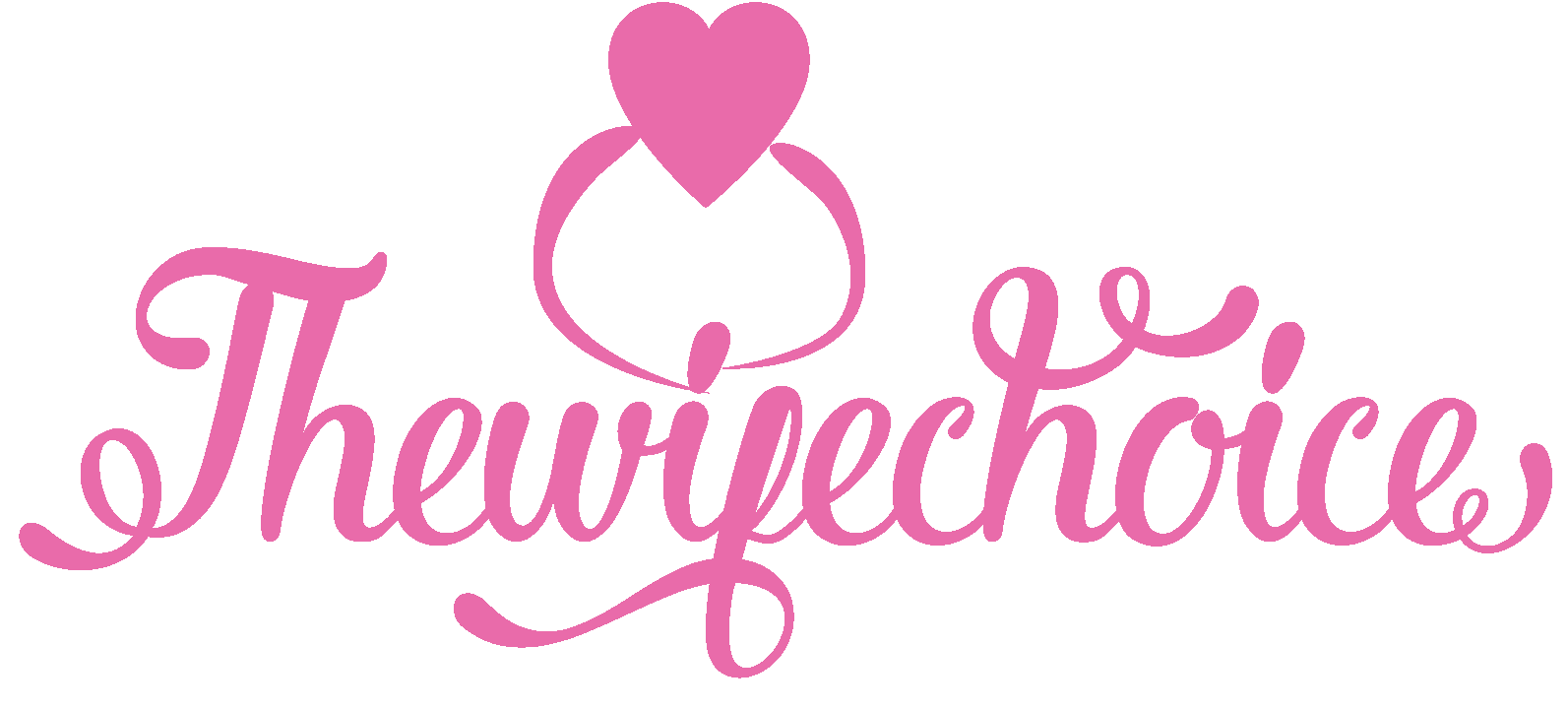
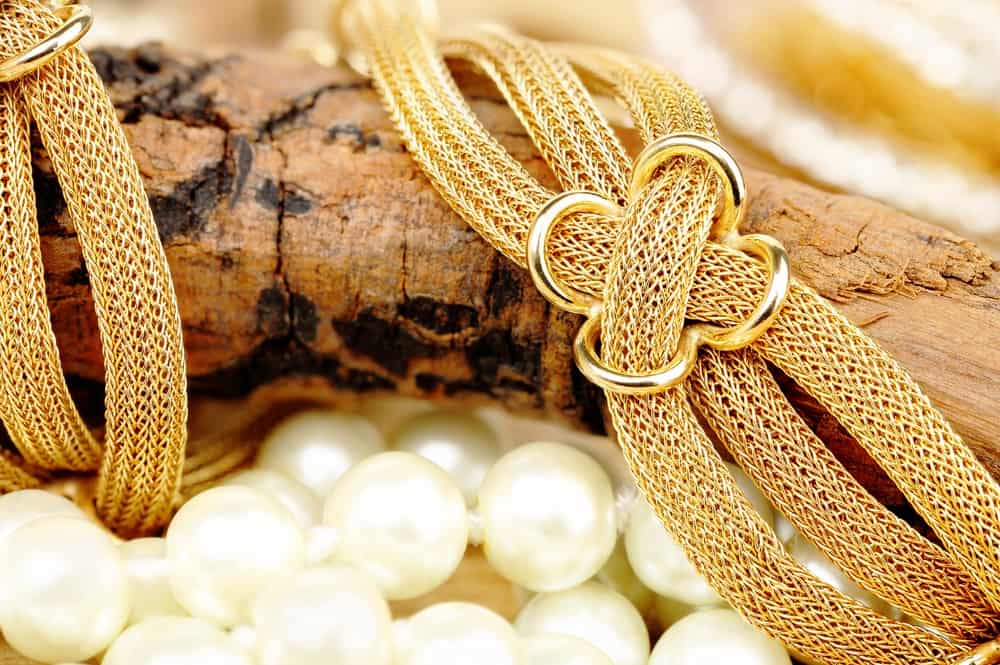
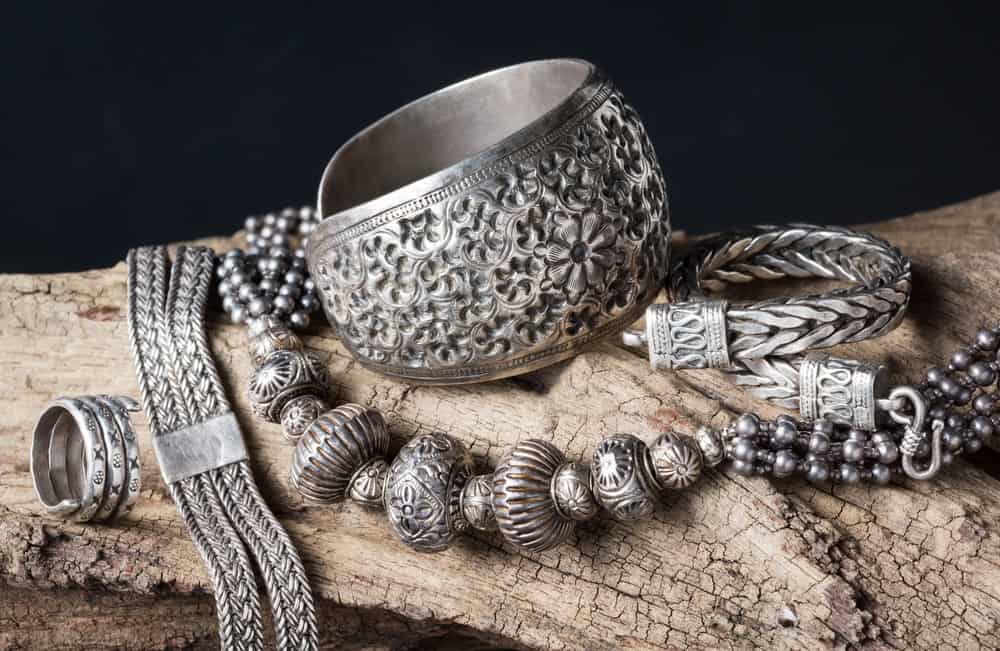
Leave a Reply